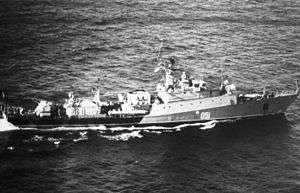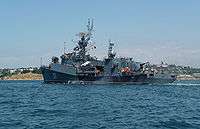Grisha-class corvette
 Grisha I-class corvette | |
| Class overview | |
|---|---|
| Name: | Grisha class |
| Builders: | Zelenodolsk Gorky Plant (340), Zelenodolsk; Leninska Kuznya (302), Kiev; Kirov Shipyard (876), Khabarovsk; Eastern Shipyard (602), Vladivostok |
| Operators: | |
| Succeeded by: | Steregushchy class |
| Completed: | 88 |
| Laid up: | 90 |
| General characteristics | |
| Type: | Anti-submarine corvette |
| Displacement: | |
| Length: | 71.6 m (235 ft) |
| Beam: | 9.8 m (32 ft) |
| Draught: | 3.7 m (12 ft) |
| Propulsion: |
|
| Speed: | 34 knots (63 km/h; 39 mph) |
| Range: | 4,000 nautical miles (7,400 km; 4,600 mi) at 10 kn (19 km/h; 12 mph) |
| Complement: | 60 |
| Sensors and processing systems: |
|
| Electronic warfare & decoys: | Bizan-4B suite with Watch Dog intercept |
| Armament: |
|
The Albatros class (Russian: Альбатрос; NATO reporting name: Grisha) was a series of anti-submarine corvettes built by the Soviet Union between 1970 and 1990 and later by Russia and Ukraine. These ships had a limited range and were used only in coastal waters. They were equipped with a variety of ASW weapons and an SA-N-4 surface-to-air missile launcher. All were fitted with retractable fin stabilizers. Russian type designation was Malyy Protivolodochnyy Korabl (Small Anti-Submarine Ship).
Variants
- Grisha I (1124.1)- 12 ships built 1970-1974 and decommissioned by 1979
- The Grisha II class (1124P) were built for the KGB border guard and marked with P for pogranichnyi meaning "on the border". This class was built only in Zelenodolsk and Vladivostok. These ships had a second 57 mm gun mounting replacing the SA-N-4 missile system forward. 17 ships were built in the 1970s. Two were transferred to the Ukrainian Navy and around seven are in service with the Russian Maritime Border Guard.
- The Grisha III class (1124M) were built in the late 1970s to early 1980s. These ships incorporated several small scale modifications, including a 30 mm gun and new electronics. Thirty four units were built. About 20 remain in Russian service. Two ships were in service with the Lithuanian Navy until 2009.
- A single Grisha IV class (1124K) ship was built in Zelenodolsk. This ship was a test ship for the SA-N-9 missile system and later was decommissioned.
- The Grisha V class (1124 ME, 1124.4) ships were built between 1985 and 1994. This incorporated further modifications with the twin 57 mm guns being replaced by a single 76 mm gun. Thirty ships were built. About 28 ships remain in the Russian Navy.
- The Grisha V class (1124 MU) ships were Ukrainian ships built after the dissolution of the Soviet Union among which is Ternopil that entered service in 2006 with the Ukrainian Navy.
- Currently on the RF ships are being modernized "Tornado 2" combat complex for antisubmarine "Zapad" type missiles firing.[3]
Gallery
| Wikimedia Commons has media related to Grisha class corvettes. |
 Grisha V-class corvette
Grisha V-class corvette Grisha V-class corvette MPK-118 Suzdalets.
Grisha V-class corvette MPK-118 Suzdalets. Grisha III-class corvette Žemaitis (Lithuanian Navy, 2003)
Grisha III-class corvette Žemaitis (Lithuanian Navy, 2003).jpg) Grisha III-class corvette Aukštaitis (Lithuanian Navy, 2003)
Grisha III-class corvette Aukštaitis (Lithuanian Navy, 2003)
See also
References
- Gardiner, Robert (ed.) (1995). Conway's all the World's Fighting Ships 1947-1995. London: Conway Maritime. ISBN 0-85177-605-1. OCLC 34284130. Also published as Gardiner, Robert; Chumbley, Stephen; Budzbon, Przemysław (1995). Conway's all the World's Fighting Ships 1947-1995. Annapolis, MD: Naval Institute Press. ISBN 1-55750-132-7. OCLC 34267261.
- "Project 1124 Albatros Grisha class". Federation of American Scientists. 2000-09-07. Retrieved 2008-01-27.
- (in English) All Grisha Class Corvettes - Complete Ship List
This article is issued from
Wikipedia.
The text is licensed under Creative Commons - Attribution - Sharealike.
Additional terms may apply for the media files.